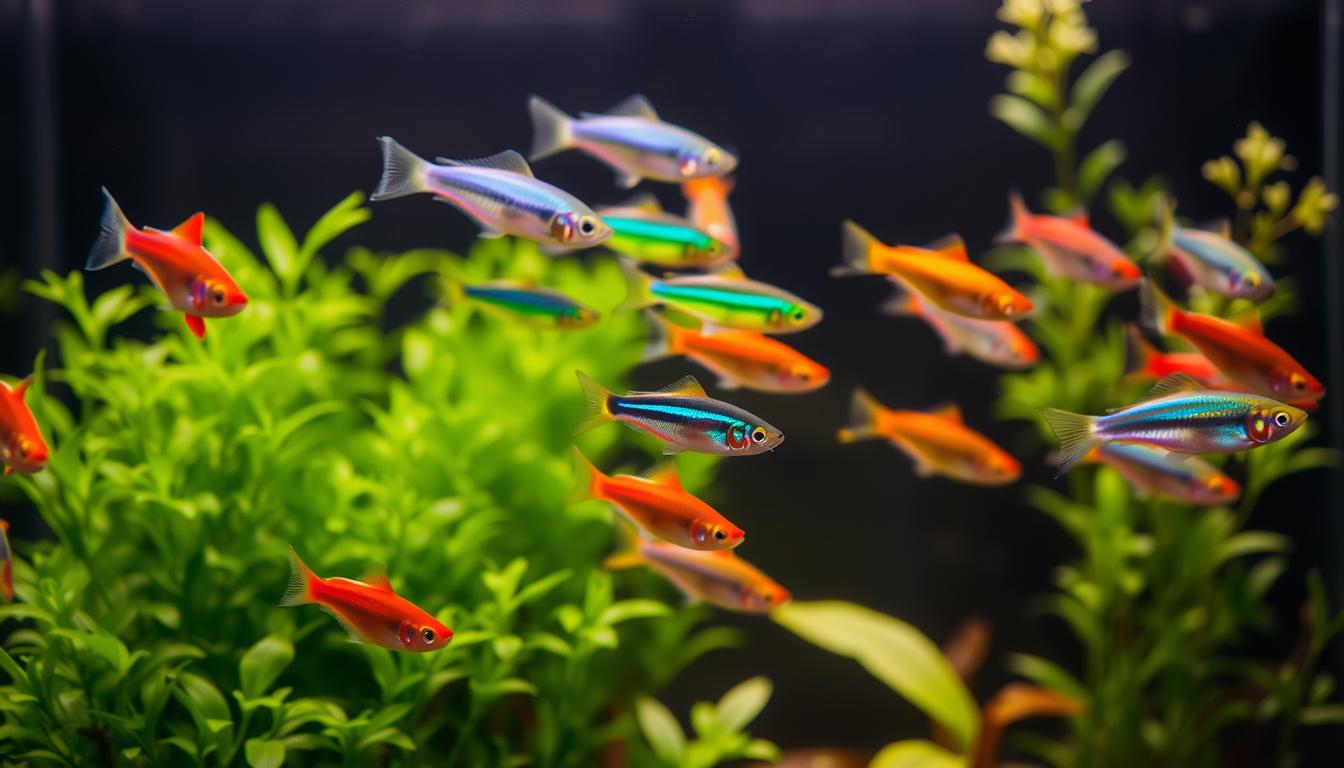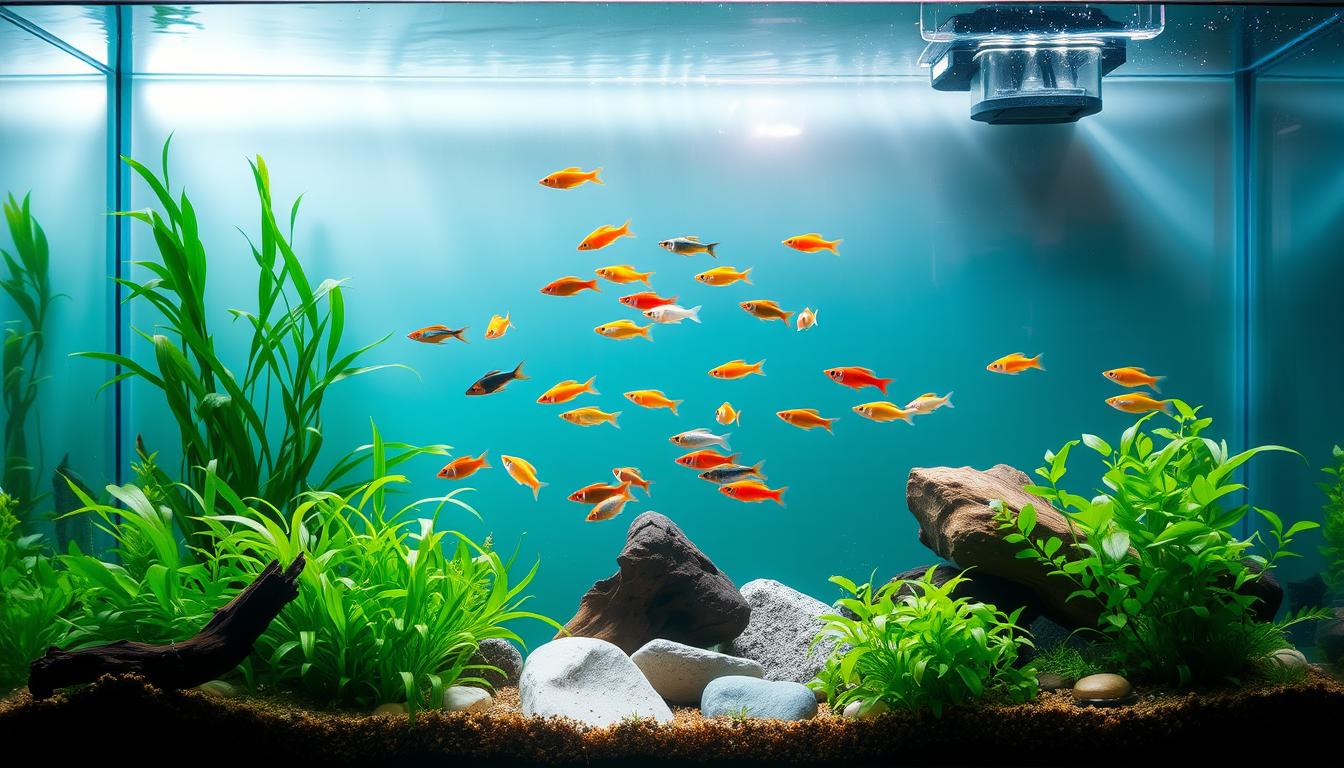How Many Tetra Fish Can I Keep in a 10 Gallon Tank Without Overcrowding?
This post may contain affiliate links.
Are you wondering how to stock your 10-gallon aquarium with tetras without causing overcrowding issues? Tetras are a popular choice for small tanks due to their vibrant colors and peaceful nature.
However, understanding the proper stocking levels is crucial for the health and wellbeing of these schooling fish. Different tetra species have varying space requirements, affecting how many can thrive in a 10-gallon tank.
Proper stocking isn’t just about the number of fish; it’s about creating a balanced aquarium ecosystem. Overcrowding can lead to stress, disease, and shortened lifespans for your tetras.
Key Takeaways
- Understand the space requirements for different tetra species.
- Learn how to create a balanced aquarium ecosystem.
- Discover the risks associated with overcrowding a 10-gallon tank.
- Find out how to maintain optimal water conditions for tetras.
- Explore the importance of proper tank maintenance.
Understanding Tetra Fish and Their Space Requirements
To create a thriving aquarium, it’s essential to understand the needs of tetra fish. Tetras are small, colorful freshwater fish that are known for their active behavior and schooling nature. They are native to the Americas and Africa, with the majority coming from the Amazon Basin and other river systems in South America.
Different Tetra Species and Their Sizes
Tetras come in various species, ranging in size from under 1 inch for ember tetras to up to 3.5 inches for Congo tetras. The size of the tetra species directly impacts the number that can be comfortably housed in a 10-gallon tank. Understanding the size and space requirements of different tetra species is crucial for maintaining a healthy aquarium.
Natural Schooling Behavior of Tetras
Tetras are schooling fish that thrive in groups. They need to be kept in schools of at least 5-6 individuals to ensure their psychological well-being. This schooling behavior affects their space requirements, as they need room to swim together in their natural patterns. Maintaining tetras in appropriate groups is essential for their health and happiness.
The Importance of Avoiding Overcrowding
Overcrowding can lead to stress indicators in tetras, including color fading, erratic swimming, and increased aggression. It also results in poor water quality, increased disease risk, and shortened lifespans. Avoiding overcrowding is crucial for maintaining a healthy environment and ensuring the well-being of tetra fish.
By understanding the different tetra species, their natural schooling behavior, and the importance of avoiding overcrowding, aquarium owners can create a thriving environment for their tetra fish. This knowledge helps in maintaining a balanced habitat that supports the health and happiness of these vibrant freshwater fish.
The One-Inch-Per-Gallon Rule and Its Limitations
While the one-inch-per-gallon rule provides a basic guideline for stocking aquariums, it has significant limitations when it comes to tetra fish. This rule suggests that a 10-gallon tank can hold 10 inches of fish, but it doesn’t account for the specific needs of different species.
Explaining the Basic Stocking Rule
The one-inch-per-gallon rule is a traditional guideline that originated as a simple way to estimate the stocking capacity of an aquarium. It implies that for every gallon of water, you can stock one inch of fish. For example, a 10-gallon tank could theoretically hold 10 inches of fish. However, this rule doesn’t consider factors like fish activity level, waste production, or oxygen requirements.
Why This Rule Doesn’t Always Work for Tetras
Tetras are active swimmers that need space to school, so they require more gallons per inch than sedentary fish. The one-inch-per-gallon rule fails to account for the schooling behavior of tetras and the space taken up by decorations and equipment in the tank. As a result, relying solely on this rule can lead to overcrowding and stress on the fish.
Better Approaches to Calculating Tetra Capacity
To more accurately determine the number of tetras a tank can support, consider the concept of “effective swimming volume” and the bioload of the fish. The table below illustrates a more nuanced approach to stocking tetras based on their size and the tank’s capacity.
| Tetra Size | Recommended Tank Size | Maximum Number of Tetras |
|---|---|---|
| Small (1-2 inches) | 10 gallons | 8-10 |
| Medium (2-3 inches) | 20 gallons | 5-6 |
| Large (3+ inches) | 30 gallons or more | Not recommended for 10-gallon tanks |

By considering these factors and using a more sophisticated approach, you can create a healthy and thriving environment for your tetra fish.
Ideal Number of Tetra Fish for a 10-Gallon Tank
To determine the ideal number of tetras for a 10-gallon tank, it’s crucial to consider the size and schooling behavior of the specific tetra species. Tetras are schooling fish that thrive in the company of other tetras, and they should be kept in odd-numbered groups of five or more fish from the same species.
Small Tetra Species
Small tetra species, such as neon tetras, ember tetras, and glowlight tetras, grow to about 1 inch in length. For these small species, you can keep 8-10 individuals in a 10-gallon tank. This number allows for proper schooling behavior without overcrowding the aquarium.
| Tetra Species | Adult Size | Recommended Number for 10-Gallon Tank |
|---|---|---|
| Neon Tetra | 1 inch | 8-10 |
| Ember Tetra | 1 inch | 8-10 |
| Glowlight Tetra | 1 inch | 8-10 |
Medium Tetra Species
Medium-sized tetra species, such as black skirt tetras and serpae tetras, grow to about 1.5-2 inches. For these species, it’s recommended to keep 5-6 individuals in a 10-gallon tank. Their larger bioload and space needs mean that fewer can be kept compared to smaller tetra species.
Larger Tetra Species
Larger tetra species, such as Congo tetras and Buenos Aires tetras, are not suitable for a 10-gallon tank due to their significant size and high bioload. These species require much larger aquariums to thrive.
When stocking your 10-gallon tank with tetras, it’s also important to observe their behavior to ensure that your tank is not overcrowded. Introducing tetras gradually and quarantining new fish before adding them to the main tank can help maintain a healthy aquarium environment.

Optimizing Your 10-Gallon Tank for Tetra Fish
Creating an ideal environment for tetra fish in a 10-gallon tank requires careful planning and attention to detail. A well-optimized tank ensures the health and well-being of your tetras.
Proper Filtration Systems for Small Tanks
A good filtration system is vital for maintaining water quality in a 10-gallon tank. Power filters and external canister filters are recommended for their effectiveness in mechanical, biological, and chemical filtration. These filters help remove toxins like ammonia and add oxygen to the water, creating a healthier environment for your tetras.
Creating the Ideal Habitat with Plants and Decorations
Tetras thrive in environments that mimic their natural habitats. Use live plants, driftwood, and rocks to create hiding spots and shaded areas. Floating plants like Java moss and dwarf water lettuce are ideal for creating shaded hiding places. This setup not only provides tetras with a sense of security but also helps in maintaining water quality.

Maintaining Water Parameters for Healthy Tetras
Maintaining optimal water parameters is crucial for the health of your tetras. The ideal water temperature should be between 75-80°F, with a pH level between 6.8-7.8. Regularly monitoring these parameters ensures a stable environment for your tetras.
Regular Maintenance Schedule to Prevent Overcrowding Issues
Regular maintenance is key to preventing overcrowding issues. This includes regular water changes, cleaning the filter, and monitoring water parameters. A maintenance schedule helps in early detection of potential problems, ensuring the well-being of your tetras.
Conclusion: Balancing School Size with Tank Capacity
The key to a beautiful tetra aquarium lies in balancing school size and tank capacity. To achieve this balance, consider the species size, schooling needs, and filtration when determining how many tetras to keep in a 10-gallon tank. For smaller tetra species, 8-10 fish are recommended, while larger species may not be suitable. Maintaining proper water parameters through regular testing and water changes is crucial for tetra health. Tetras are schooling fish that thrive in groups of at least 5-6 of the same species. A well-maintained 10-gallon tank can be a healthy environment, but consider upgrading if you want to keep more or larger tetras. Ultimately, the quality of care is more important than the quantity of fish.
Monitor fish behavior to ensure your tank is properly stocked. With proper planning and maintenance, a small school of tetras can thrive.
